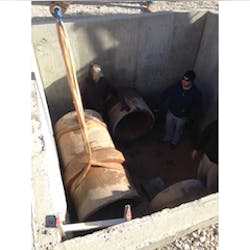Oklahoma Water District Installs Butterfly Valves to Help Modernize Its System
The Foss Reservoir Master Conservancy District (FRMCD) in southwestern Oklahoma resides at the 8,800-acre Foss Reservoir/Foss Lake. The treatment plant, located adjacent to the Foss Dam, pumps water from three pumping stations through 50.8 total miles (81.8 km) of concrete transmission lines, all of which were built between 1958 and 1961. The FRMCD serves 17,000 consumers in several towns.
The problem
The concrete bar-wrapped tongue-and-groove pipe transmission lines that carry water to these towns are aging. The FRMCD, as well as operators of many other government-constructed water distribution systems developed in postwar years, lacked the funding to install main valves in the system to isolate the towns being served. With the passage of time, erosion of the concrete pipe caused leakages. High pressure and reverse flows caused fittings failures, and until recently, whenever a leak occurred, standard operating procedure necessitated shutting down the entire system to make repairs. Clearly, a more effective alternative was needed for uninterrupted water delivery.
The solution
Beginning in late 2013, pipeline repairs were made at the FRMCD that included the installation of Mueller/Pratt butterfly 150B 18-, 24- and 30-in. 150-psi isolation valves at each point where a line enters a city. Designed specifically for the waterworks industry, Pratt butterfly valves offer the ruggedness and reliability required for buried service. The body-mounted elastomeric seat has ridges, which provide multiple sealing lines and permit higher levels of radial compression. As a result, stress in the seat material is reduced, allowing lower seating torques and optimal sealing action.
The aging water towers and water storage tanks of the FRMCD also required periodic maintenance, requiring the shutdown of their individual supply lines and emptying of the particular vessel. In addition to Mueller/Pratt valve installations at locations where water mains route to the towns served by the FRMCD, Mueller/Pratt valves were installed at tees within concrete vaults, where transmission lines lead to water towers and tanks. This arrangement permits continual flow of water throughout the rest of the system while supply lines to and from each vessel can be independently closed as needed.
During the past two years, drought has plagued the area, causing a significant portion of Foss Reservoir to run dry. The lake is currently 16.5 ft (5m) low, and only one of the four intakes is supplying water. Naturally, greater control of water delivery to consumers within the system has become more critical. However, due to the system improvements cited above, no customer is without water in the district. Another significant benefit has been realized with this program: Whereas many of the projects of this type have necessitated the procurement of special projects funding to make repairs and improvements, this project has been completed on a routine, scheduled basis under the maintenance category using funds that come out of the existing maintenance budget.
The result
Water is now flowing uninterrupted to consumers regardless of whether maintenance is being performed at points within the system. All design and project objectives of the repair and improvements program at the FRMCD have been met or exceeded. Turnaround times for repairs and installations have been short, and there have been no problematic hitches in the program. The case can certainly be made for the advantages of this type of improvement program for similar water distribution systems.
